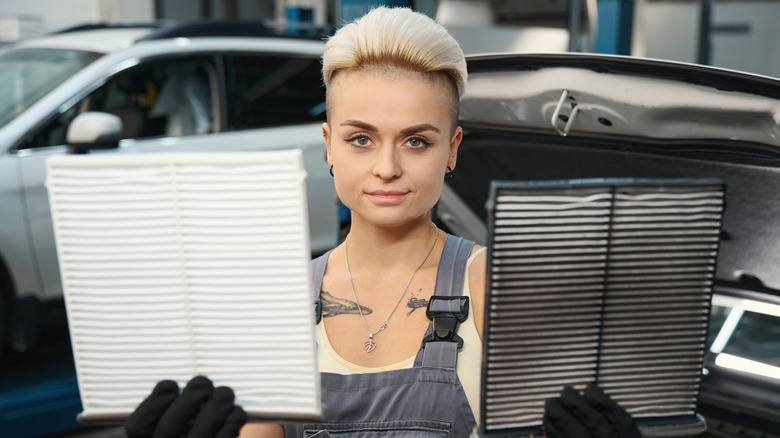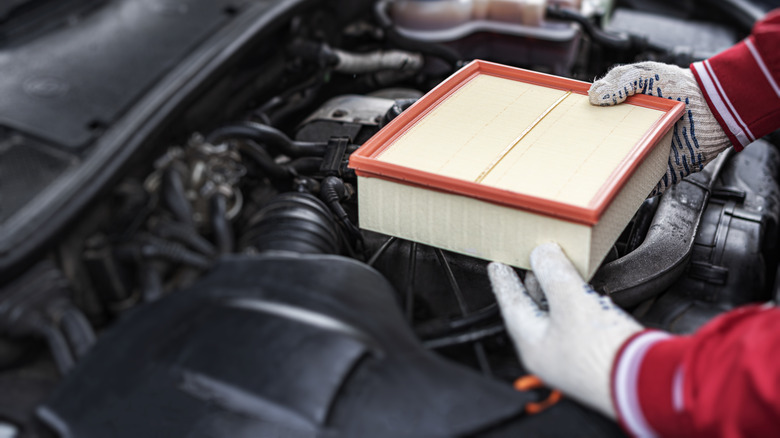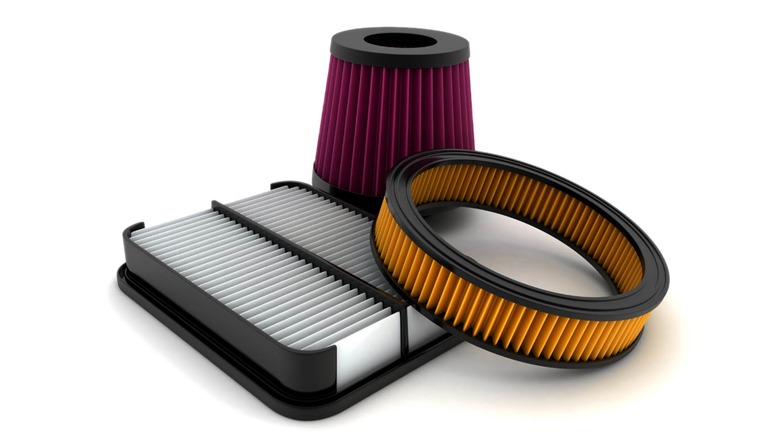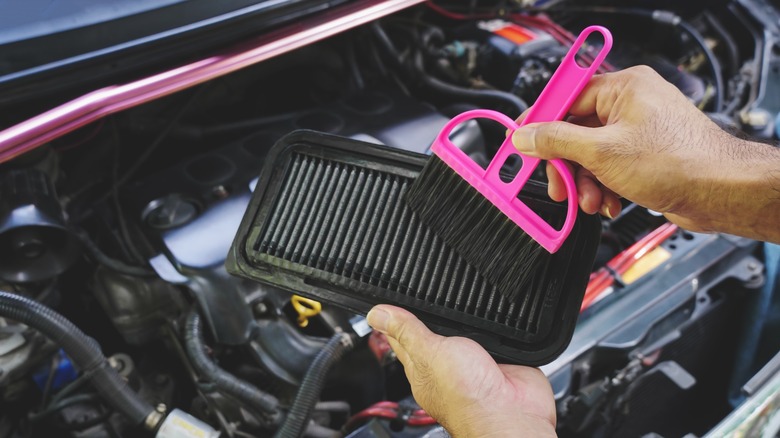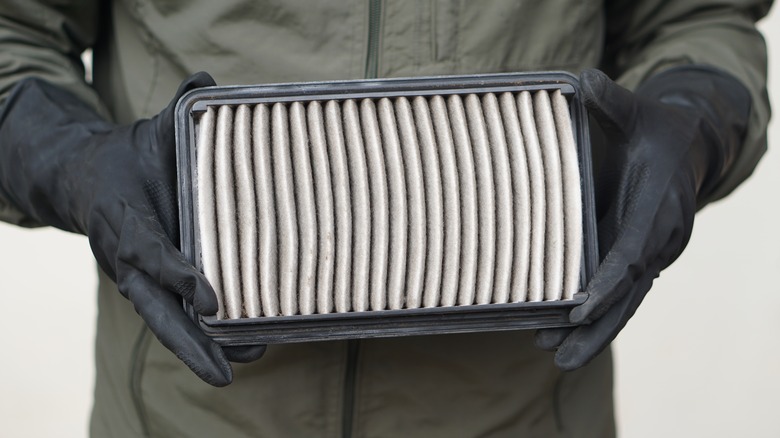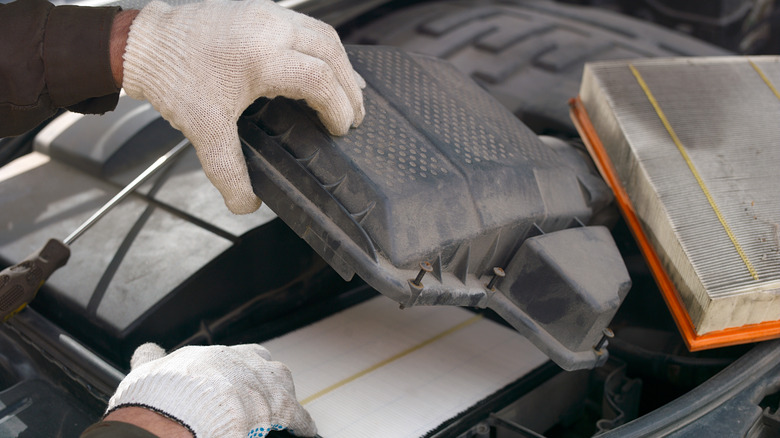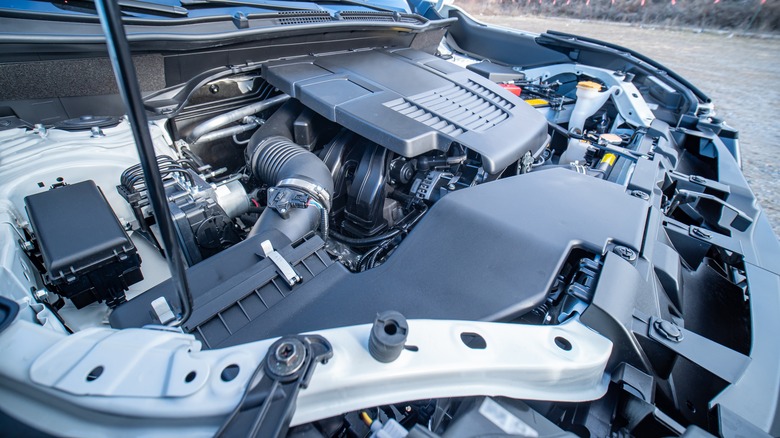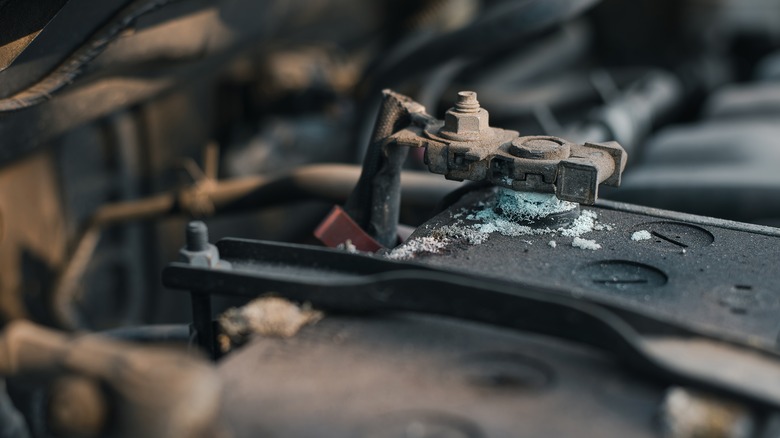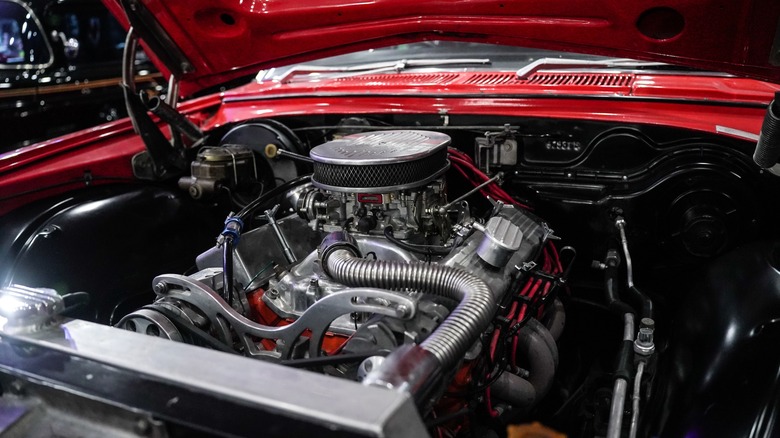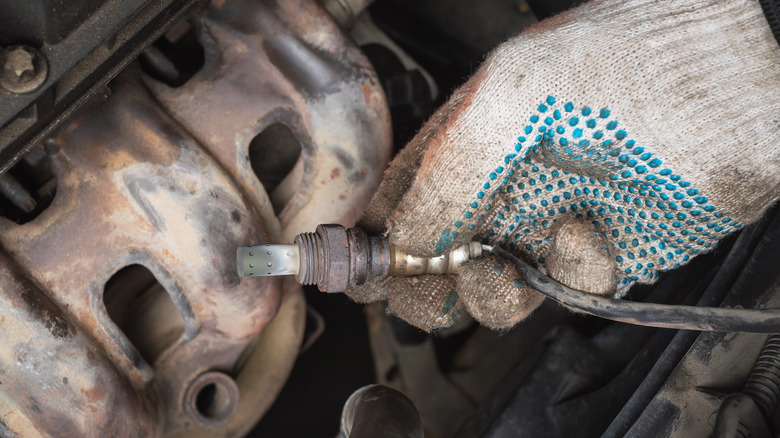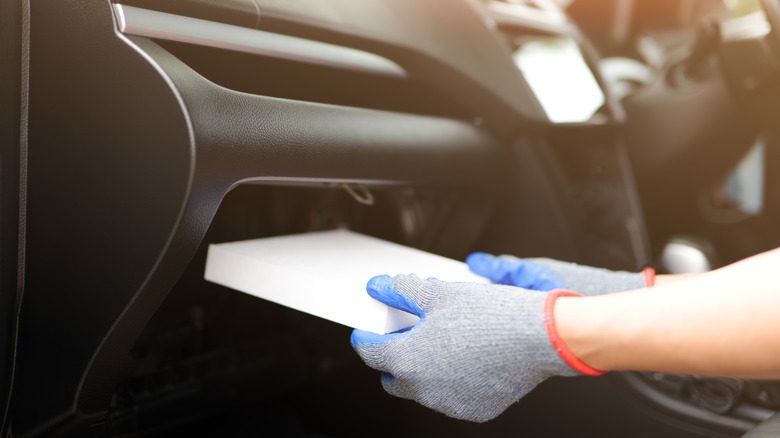10 Mistakes You Might Be Making When Changing The Air Filter In Your Vehicle
Taking time out of your day to take your vehicle to an auto shop can be a pain, especially if you only need to get some minor maintenance done. It can be a lot simpler to take care of certain tasks at home, like replacing the engine air filter. Learning how to change the engine air filter on your vehicle is a breeze, typically only taking about 15 minutes. Most people should be able to do this, but given the task's relative simplicity, it's important not to overlook any crucial steps, or you could wind up doing more harm than good.
It may seem like a no-brainer, but the air filter is something you don't want to trifle with. It's responsible for filtering out particles from the air your car draws in, which optimizes engine performance. This ensures that there's a proper ratio between fuel and air, but over time, the filter gets dirty. It becomes less efficient at cleaning the air, and your engine may get particles inside that hamper its operation.
Better engine performance is just one of several benefits of changing the air filter on your vehicle. Your mechanic will know when your car's due for a new one, but if you want to take care of the maintenance at home, these are some mistakes to avoid so that you don't inadvertently cause damage to your engine in the long-run.
Not changing the air filter often enough
Most car maintenance is fixed on a mileage basis. When it comes to your engine air filter, you should ideally change it for a new one every 12,000 to 15,000 miles. It's the same frequency with which you should be inspecting and replacing your vehicle's fluids and performing brake inspections, so while you're at it, you should get a new air filter to go with everything else. For an average driver, this usually comes out to about once per year, but if you don't really drive much, it's still recommended to replace the filter annually.
A lot can happen if you never change your car's engine air filter. For one, you may begin to notice worse fuel economy. Your engine will require more fuel to compensate, so you could spend significantly more at the pump as a result. The engine itself will begin to function more poorly, and in the worst possible outcome, it could fail entirely.
A professional mechanic will know to give your vehicle a new air filter at every 15,000-mile interval. However, your car may need a new air filter sooner if you drive in particularly dusty conditions. Driving over dirt roads can make your filter dirtier more quickly, so if you crack open the hood and notice your filter's filthy before the 15,000 mile mark, you're still better off replacing it right then and there.
Buying a new cheap filter
There are many reputable automotive air filter brands you can buy from and even more variations. You can find filters constructed out of paper, gauze, or foam, with each one offering specific benefits for your engine's performance. As you sort through which ones are right for your car, it's important to remember not to simply purchase the cheapest option. You're already saving money by replacing your car's air filter yourself, so it's not prudent to hedge your bets even more while putting your vehicle at risk.
Some cheaper models can wear out too quickly or still allow particles to enter the engine, defeating the purpose of having a filter in the first place. You want to make sure you buy something high-quality that isn't going to wear out in a month or so. However, there's also the opposite side of the spectrum to consider.
There are plenty of high-performance engine air filters in the marketplace, so you may be tempted to opt for those. Certain aftermarket air filters may be considered a modification by your dealership, thus voiding the warranty. You don't want that to happen, either, so it's best to consult with your dealer to see which air filters are recommended. Typically, you can search for proper air filters by make, model, and year of your vehicle to ensure you're getting something ideal for your needs.
Cleaning the old filter (when you shouldn't)
Another way people think they can save money on an engine air filter replacement is by simply cleaning the old one. This can be done via brushing or soaking it in a cleaning solution, but you only want to pursue this if the filter is specifically designed to be cleaned and reused. Unless the filter was explicitly marketed as being "reusable," you should purchase a new one instead.
Cleaning an air filter that shouldn't be cleaned and then reinstalling it can cause major issues. The cleaning process can damage the filter's underlying structure, making it less efficient in clearing away particles from the air. If impurities get into the engine, they can impact various other components, leading to additional replacements sooner than you would've liked. For instance, if a cylinder breaks due to particles in the engine system, that could cost several hundred dollars to fix at minimum. It's much easier and more cost-efficient to purchase a new air filter if you're in doubt.
There's nothing wrong with utilizing reusable air filters as long as you know they can, in fact, be cleaned. It'll probably cost more than a standard air filter, but the extended usage may make it worthwhile over time.
Buying an incorrect size
Every driver should know exactly what engine air filter they need. The owner's manual should showcase the precise parts number for your air filter so that there's zero guesswork when it comes to buying a new one. If all else fails, you can remove the air filter from its storage unit and take it to the store with you. A worker can then get you a perfect replacement that's the exact size needed. Attempting to guess on size can lead to disastrous results, so it's vital to triple-check just in case.
A filter that's too large probably won't even fit in the unit, meaning you'll have to go back to the store to get a new one. On the other hand, a filter that's too small will make it so that air in the system can bypass the filter completely, leading to contamination.
Air filters tend to either come as panels or cones, with panels needing to go in specific housing. You're really locked in with how big a panel air filter can go, and you should notice right away if there's too much leftover room in the housing when installing one. Cone-shaped filters typically don't have housing, so you mostly just need one that connects to the air intake plumbing without issue.
Putting the air filter in backward
Car engine air filters are designed to be put in one way. There's one side designed to collect debris, and if the filter's in backward, then it won't adequately remove particles from the air. Normally, installing an air filter backward isn't too much cause for concern, as most housing units are designed to allow the filter to slot into place only one way. Even still, people have managed to get the filter in backward one way or another.
In a December 2022 Reddit post, user u/galb811 spoke about how they took their 2020 Nissan Rogue in for professional maintenance and still had to deal with this problem. "Turns out at my last oil change they put the air filter in backward which caused the air flow sensor to fail," they wrote, "to the tune of $600." Everything worked out all right for them in the end, but it's a good reminder of how even professionals can get things wrong sometimes.
Anyone planning on replacing an air filter themselves would do well to remember not to force anything. Most housing compartments are designed to only let the filter enter in one direction. You shouldn't have to force it into place, and when in doubt, make sure to look up the year, make, and model of your vehicle online. There's bound to be diagrams or videos showing how to properly install the engine air filter.
Failing to check gaskets for damage
As you replace the air filter, it's vital to inspect the other components within the housing to ensure everything still looks good. These parts should be more durable than the filter itself and usually don't require replacement every 15,000 miles. However, it's a good opportunity to ensure everything still looks solid and hasn't sustained any damage. If any other housing components are broken, now would be a good time to replace them so that your new filter has the best shot of doing its job perfectly.
A key part to look at is the gasket providing a seal between the filter and the rest of the housing. Over time, this gasket can become broken or deformed, losing the viable seal and potentially allowing air into the engine that hasn't been filtered. In general, gaskets are designed to be durable, so this isn't something you should worry about all the time. But when it comes to proper car maintenance, it never hurts to be extra cautious.
In addition to inspecting the gasket, it's recommended to do a quick search of the plastic housing and any clips to make sure those are all looking good, too. Again, this really shouldn't be something to concern yourself too much with, as these parts should last much longer than a standard air filter. But since you have the hood open anyway, it's a good time for a brief examination.
Dropping debris in the engine bay
When you remove the old engine air filter, you may discover other pieces of debris, such as leaves or miscellaneous fuzz, in the filter housing. This is normal, and since you're installing a brand new, squeaky-clean filter, you'll want to set it up on the best footing possible. Use this opportunity to clean out the housing. You don't even have to remove any other parts, as you can generally just vacuum out any debris to ensure the housing is ready to receive the new filter.
Vacuuming is usually the way to go, as trying to pick up debris can lead to you accidentally dropping items into the engine bay. A few leaves here and there may not seem like a big deal, but any items getting where they shouldn't can hamper performance elsewhere. While the hood's open, do a quick visual check to ensure the rest of your engine's looking good.
Leaves and stems are one thing, but there have also been accounts of people finding bees and wasps in their car's filtration system. The housing should ideally keep critters at bay, but any openings in the system put your car at risk of becoming a nest. If you find live bugs or animals in your car, consult a professional and don't attempt to remove them on your own.
Not changing the air filter after engine modifications
There are plenty of affordable ways to boost your engine's performance, with one of the simplest being to enhance the air intake system. This can be as easy as opting for an aftermarket high-performance air filter that can increase the level of air flow to the engine. As mentioned earlier, you should consult with your dealer before installing any aftermarket parts to make sure they don't negate any warranties. For anyone with a need for speed, though, this may be the way to go.
Most standard air filters are built using paper, but high-performance ones tend to be made from cotton or foam. Tests have been performed that show how a higher-quality model can swell your car's horsepower by as much as 2% to 3% with an added boost in acceleration time. Getting one of these filters may be necessary if you plan on doing any additional modifications to the engine itself. A boosted engine might require a different kind of air filter so that it can get the oxygen intake it needs for the most optimal performance possible.
Not only do you get improved engine performance and enhanced mileage with these kinds of filters, but they tend to be reusable too. This is an instance where you actually can clean your air filter and put it back in because it's not just paper.
Accidentally disconnecting sensors
Replacing an engine air filter is a fairly straightforward process that shouldn't take long on your own. It's really just a matter of removing the old filter from its housing and putting the new one in, making sure to clamp the housing shut when you're done. However, there might be certain things in your way, or perhaps you toss the old filter elsewhere in the engine bay and accidentally knock something loose. It's critical to be mindful of anything that might've been disconnected throughout the filter replacement process so that you can plug it back in before starting the engine again.
Even if you don't notice anything amiss at the moment, you'll likely become quickly aware as the engine may not work as it should once you start it up. You may even notice the check engine light turn on, which is a clear indicator that something went wrong. Fixing this is usually just a matter of plugging any sensors or miscellaneous wires back in.
One common component at risk of getting dislodged during an air filter replacement is the mass airflow sensor. This is a cylindrical part generally found next to the air filter housing. Driving with this sensor unplugged can cause performance issues, which you'll likely become aware of right away.
Forgetting to change that other air filter
The engine air filter is critical for making your engine perform optimally. However, you don't want to overlook the other air filter in your car that serves a different but similarly vital function. There's still the matter of your cabin air filter, which removes particles and contaminants from the air. This is the air that you breathe, so you definitely don't want it to be filled with debris.
The cabin air filter should be on the same replacement schedule as the engine's, meaning you should swap it out once every 12,000 to 15,000 miles. Ideally, you'll keep these within the same frequency, so if you replace one, you know to do the other. There may also be signs informing you that it's time for a change sooner than expected. For example, if you notice your car takes longer to cool down even if you have the AC on full blast, it could be a sign your cabin filter is dirty and needs replacing. There may also be sounds like whistling coming from the ventilation system that should raise any alarms.
Replacing both the engine and cabin air filters are DIY car maintenance tasks you can do yourself at home. You'll still need to buy new parts, but you can save some money on labor. As long as you know what to do, you can keep your car running smoothly until something big comes along that genuinely requires a professional inspection.
